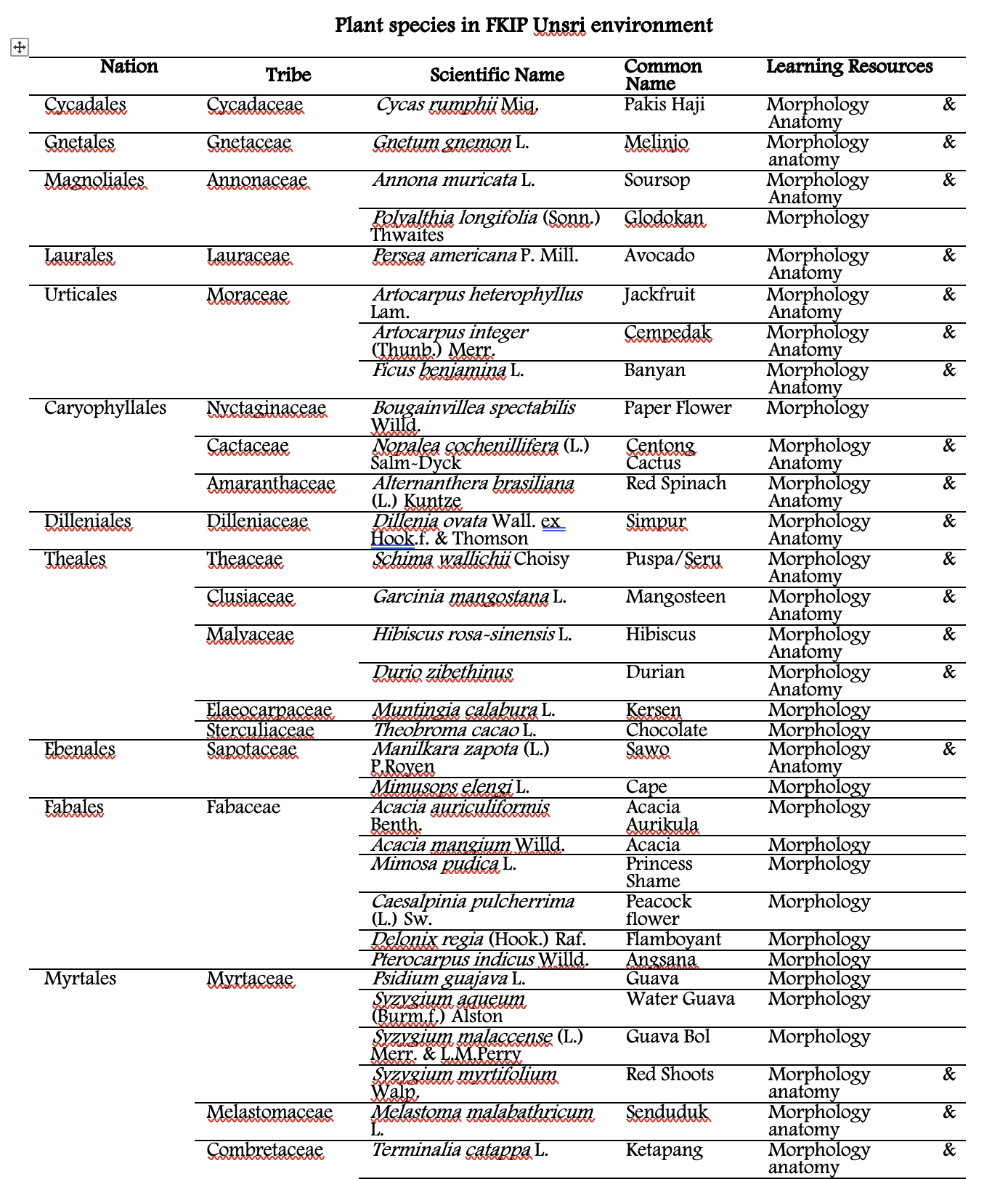Plant Species in The Environment of FKIP Unsri as A Learning Resource in Plant Morphology and Anatomy Practicum
Main Article Content
Abstract
The environment as a learning resource has long been the object of research studies in various fields, especially plant morphology and anatomy. This study aims to determine the types of plants in the FKIP Unsri campus environment, which can be used as a learning resource in the practicum of Plant Morphology and Anatomy. The method used is descriptive. Plant data were collected by exploring techniques. The data obtained were identified and described based on morphological characters. The next step was to analyse the topics of morphology and plant anatomy practicum by referring to the identification results. The results showed that there were 114 species of seed plants belonging to 29 nations and 51 tribes, which could be used as learning resources in morphology practicum (100%) and plant anatomy (36%). Based on the analysis of practicum topics and plant availability, it is known that the campus environment provides 87.5% of plant morphology practicum materials and 81.3% of plant anatomy practicum materials. So it can be concluded that plants found in the FETT campus environment can be used as a learning resource for plant morphology and anatomy.
Article Details

This work is licensed under a Creative Commons Attribution-ShareAlike 4.0 International License.
References
Backer, C. A., & Brink, R. C. B. Van De. (1965). Flora of java (spermatophytes only). Netherlands: The Auspices of the Rucsherbariu.
Christenhusz, M. J. M., Reveal, J. L., Farjon, A., Gardner, M. F., Mill, R. R., & Chase, M. W. (2011). A new classification and linear sequence of extant gymnosperms. Phytotaxa, 19, 55-70.
Coté, G. G. (2009). Diversity and distribution of idioblasts producing calcium oxalate crystals in Dieffenbachia seguine (Araceae). American Journal of Botany, 96(7), 1245-1254.
Crisp, M. D., & Cook, L. G. (2011). Cenozoic extinctions account for the low diversity of extant gymnosperms compared with angiosperms. New Phytologist, 192(4), 997-1009.
Eriawati. (2016). Utilisation of plants in the school environment as natural media on plant diversity material in SMA and MA Montasik District. Biotic Journal, 4(1), 47-59.
Hamdani, Prayitno B.A., Karyanto. (2019). The Improve Ability To Think Critically Through The Experimental Method. Proceeding Biology Education Conference. 16(1), 139-145.
Hartono, A., M. N. Adlini, Y. E. Ritonga, M. I. H. Tambunan, M. S. Nasution, Jumiah. (2020). Identification of Higher Plants (Phanerogamae) on Campus Ii Uinsu. Biolokus Journal: Journal of Biology and Biology Education Research. 3 (2). 305-312.
Herawati, W., Sukarsa, P. Widodo, D. Palupi. (2023). Utilisation of Plants as an Environment-Based Biology Learning Media at SMAN Iv Purwokerto. Proceedings of the National Seminar and Call for Papers "Development of Sustainable Rural Resources and Local Wisdom XIII". 443-448.
Hutasuhut, M. A. (2020). Inventory of araceae in sibayak 1 forest, sibolangit sub-district, deli serdang district, North Sumatra. Journal of Biolokus, 3(1), 288-292.
Irsyam, A. S. D., Yus, R. R., Hariri, M. R., & Irwanto, R. R. (2021). The araceae of itb jatinangor campus, sumedang, west java. Scientific Journal of Experimental Biology and Biodiversity, 8(2), 38-52.
Liunokas, A. B., & A. H. S. Billlik. (2021). Development of a Textbook on Plant Morphological Characteristics to Improve Students' Ability to Identify Plant Species. Basicedu Journal. 5(6) 5877 - 5884.
Nurlaeliana, Satriani, Rezki. (2022). Analysis of the Potential of Local Plants as a Learning Source for Plant Structure and Function Materials. Holan Journal: Journal of Science and Technology. 2(2), 71-75.
Novia, M. N. S., Zahra, N. H., & Supriatna, A. (2023). Inventory of araceae family at faculty of science and technology sunan gunung djati state islamic university. In International Journal of Engineering, Economic, Social Politic and Government, 1(3), 17-21.
Pebrina, A. M. & T. Yuliani. (2012). The Role of Plants in Schools as a Learning Media for Students at SDN 105306 Keriahen Tani, North Sumatra. Pros. National Seminar. Improving the Quality of Education. 2(1), 145-150.
Piper, F. I., Hoch, G., & Fajardo, A. (2019). Revisiting the relative growth rate hypothesis for gymnosperm and angiosperm species co-occurrence. American Journal of Botany, 106(1), 101-112.
Qomah, I., S. A. Hariani, S. Murdiyah. (2015). Identification of Seed Plants (Spermatophyta) in the Campus Environment of the University of Jember. Bioeducation Vol. XIII No. 2. 13-20.
Rahmawati, U. N. A. (2020). Utilisation of the Environment as a Learning Resource in Mimpundungrejo in the 2019/2020 Academic Year. Jenius: Journal of Education Policy and Elementary Education Issues. 1(1) 16-25.
Risafitri, Suparni, W. R. Nasution. (2024). Implementation of the Utilisation of the Natural Environment as a Learning Source in Science Subjects in Class Iv Sd Negeri 200508 Sihitang Padangsidimpuan. Journal of Islamic and Scientific Education Research. 63-71.
Shofiyati, A. (2019). Identification of Plants in the School Environment for the Development of Discovery Learning Model Learning Modules. Thesis. Postgraduate programme, Semarang State University.
The Gymnosperm Database. (2024). Gymnosperms. Available at https://www.conifers.org/zz/gymnosperms.php. [Accessed on 2 March 2024]
Ulfa S. W., A. H. Nasution, F. E. Saragih, P. R. Achyari, S. Amelia, Y. Sinurat. (2023a ). Identification of Higher Plants (Phanerogamae) in Percut Sei Tuan District. Journal of Education and Teaching Review, 6 (4), 2996-3010.
Ulfa S. W., A. Marhamah, D. Hardiansyah, P. Rahayu, T. N. Aqmarina. (2023b ). Identification of Morphological Characteristics of Higher Plants in Different Orders on Campus IIUINSumatera Utara. BIOSFER, J.Bio. & Pend.Bio. 8(2), 154-164.
Vaidya, M. (2016). Stomatal complexes in some species of Araceae. World Journal of Pharmaceutical Research, 5(7), 1037-1047.
Wäldchen, J & P. Mäder. (2016). Plant Species Identification Using Computer Vision Techniques: A Systematic Literature Review. Arch Computat Methods Eng 1-38. DOI 10.1007/s11831-016-9206-z
Yang, Y., Wang, Z. H., & Xu, X. T. (2017). Taxonomy and distribution of global gymnosperms. Shanghai: Scientific and Technical Publisher.

